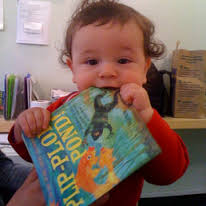by Katrina Morse for Family Reading Partnership
Before the age of 5, children are usually on the go, learning about their world by exploring. How can you share a book with a wiggly child who has a short attention span? Use some of these strategies while your child is growing to have more self-awareness and concentration:
- Read books that encourage movement and act out the story together.
- Read books that are interactive and require your child to look for details in the illustrations or guess what happens next.
- Pick a time of day to read aloud when your child isn’t wound up and is more likely to slow down and listen.
- Give your child something to do with his or her hands while you are reading, such as holding a small toy or making marks with a crayon on paper.
- Be ok with your child getting up in the middle of the story and coming back to hear more.
- Don’t force it. If your child doesn’t want to listen, choose another book or another time to read aloud.

- Keep read-aloud fun for everyone!
Try some of these books about animals in motion with your active youngster:
“Waddle!” by Rufus Butler Seder. One of a series of board books made with a technique called “scanimation” that layers transparent illustrations on top of each other. When you turn the page, the scanimation picture looks like it’s moving. In this board book there is plenty of word play with alliteration and rhyming. “Can you hop like a frog? Flip. flop. flop.” Each page features one animal and asks the young child to do some pretending and moving.

“Dancing Feet” by Lindsey Craig, illustrated by Marc Brown. Babies will be visually mesmerized by the patterns of animal footprints illustrated in “Dancing Feet” and toddlers will respond to the rhythm and rhyme of the text. The story is packed full of actions you can do with your child along with guessing which animal will be on the next page. This book received a Gold Award from National Parenting Publications.
“Move!” by Robin Page, illustrated by Steve Jenkins. Perfect for a toddler, this book asks the listener to slither like a snake, leap like a frog, and make the motions for all kinds of animals. Your child will learn how his or her body can move! Check out the author’s other books for more animal adventures.











